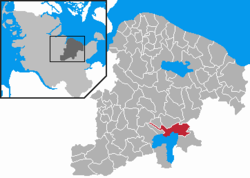Plön
| Plön | ||
|---|---|---|
 |
||
|
||
| Coordinates: 54°9′44″N 10°25′17″E / 54.16222°N 10.42139°ECoordinates: 54°9′44″N 10°25′17″E / 54.16222°N 10.42139°E | ||
| Country | Germany | |
| State | Schleswig-Holstein | |
| District | Plön | |
| Government | ||
| • Mayor | Jens Paustian | |
| Area | ||
| • Total | 36.73 km2 (14.18 sq mi) | |
| Population (2015-12-31) | ||
| • Total | 8,806 | |
| • Density | 240/km2 (620/sq mi) | |
| Time zone | CET/CEST (UTC+1/+2) | |
| Postal codes | 24301–24306 | |
| Dialling codes | 04522 | |
| Vehicle registration | PLÖ | |
| Website | www.ploen.de | |
Plön (German pronunciation: [ˈpløːn]) is the district seat of the Plön district in Schleswig-Holstein, Germany, and has about 8,700 inhabitants. It lies right on the shores of Schleswig-Holstein's biggest lake, the Great Plön Lake, as well as on several smaller lakes, touching the town on virtually all sides. The town's landmark is Plön Castle, a chateau built in the 17th century on a hill overlooking the town.
Plön has a grammar school with a 300-year history, and is home to a German Navy non-commissioned officer school and the Max Planck Institute for Evolutionary Biology. The town, nestled as it is in the hilly, wooded lake district of Holstein Switzerland (Holsteinische Schweiz), also has importance in the tourism industry.
In the course of the Migration Period, Slavic tribes entered the region of Plön during the early 7th century following the withdrawal of the original Germanic population. On the large island opposite Plön, which was later called Olsborg, they built a large fortification. They called their settlement Plune, which means "ice-free water".
In 1075, Kruto lured Budivoj of the Nakonids into the "castrum plunense" (according to Helmold of Bosau), laid siege to him, and then once Budivoj's men had given themselves up after Kruto's promises to let them withdraw freely, Kruto had them slain. In 1139 the Holstein count, Adolf II of Schauenburg, destroyed the fortress, ending the domination of the Slavs in the region of Plön. Twenty years later, Adolf II had the castle on the island rebuilt, but soon had it moved to the present hill of Schlossberg ("castle hill"). It was here, under the protection of the castle and close to the major trading route from Lübeck to the north, that a Saxon market town emerged.
...
Wikipedia



